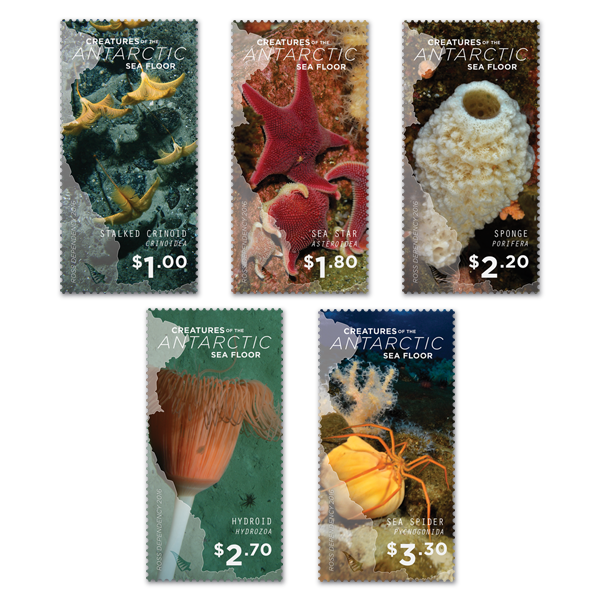Although it’s covered in ice for most of the year, the Ross Sea is teeming with life.
A set of five stamps recently issued by New Zealand Post explores some of the creatures found on the floor of the Ross Sea, which is a deep bay of the Southern Ocean. Developed with the assistance of the National Institute of Water and Atmospheric Research (NIWA) and Antarctica New Zealand, these 2016 Ross Dependency stamps show some of the most diverse invertebrate communities of the Southern Ocean. In stark contrast to the animals living above the ice, the sea floor creatures are often colourful and definitely unique; more than half of Antarctic marine species aren’t found anywhere else in the world.
Because of the stable and narrow range of conditions they experience in their habitats, there’s growing concern about how these animals will adapt to a rapidly changing ocean environment. An area of concern is how the creatures might cope with rising temperatures and the modifications this will cause to their wider ecosystem. A warming ocean may also enable some organisms to expand their distributions, and the introduction of new species also brings its own set of challenges.
These seafloor animals are well adapted to life in this cold, dark and unique environment, where conditions have remained consistent for millions of years, and where they have evolved in isolation. The beauty, diversity and uniqueness of these animals is exemplified by the recent issue by New Zealand Post.
“Most people associate icy whites and blues with Antarctica, so we think they’ll be amazed by the vibrant, colourful life below the ice,” said New Zealand Post Concept and Design Specialist Helcia Knap.
 $1 Stalked crinoid
$1 Stalked crinoid
These beautiful stalked crinoids (sea lilies) are found on seamounts north of the Ross Sea. They are suspension feeders, using their stalks to raise them into the currents above the sea floor. Their feather-like arms trap fine food particles in the water and transfer the food to their mouths at the centre of the feeding arms.
 $1.80 – Sea star
$1.80 – Sea star
Odontaster validus is the most common sea star of the Antarctic and is found in large numbers in the Ross Sea, and also on some of the seamounts north of the Ross Sea. This bright pink species has a voracious appetite – it actively hunts prey of many types, but will also scavenge the remains of other sea creatures and can even feed on plankton.
 $2.20 – Sponge
$2.20 – Sponge
Haliclona dancoi is a relatively common Antarctic sponge that forms frilly, lumpy single or multiple vases. Food and oxygen is captured from seawater that is sucked in through tiny holes in the outer surface of the sponge, exiting through openings on the inside of the vase. The sponge is soft and pliable.
 $2.70 – Hydroid
$2.70 – Hydroid
This hydroid may look like a flower, but it is an animal. This large and beautiful species was first recorded in the Antarctic during a 2008 voyage to the Ross Sea. Although most hydroids are colonial organisms, Branchiocerianthus is a giant, solitary hydroid that feeds by capturing food particles and small planktonic organisms from the water.
 $3.30 – Sea spider
$3.30 – Sea spider
Sea spiders are only loosely related to land spiders. They feed on sponges, bryozoans, and other sessile organisms, using a long proboscis to pierce their prey and suck out the insides. Their bodies are small in comparison to their long legs; so small that their intestines extend into their legs. Eggs are brooded by males, carried under the body on specialized appendages called ovigers.
EFFECTS OF CLIMATE CHANGE
“There is concern about how a rapidly changing ocean will affect these animals, and how they might cope with warmer sea temperatures and more acidic water,” said Antarctica New Zealand General Manager Communications Jeanine Foster. “These stamps show just how beautiful and unique these creatures are.”
The images featured on the stamps were captured by NIWA marine ecologists. Printed by Southern Colour Print using four-colour offset lithography plus varnish, the stamps measure 25 mm x 50 mm. A miniature sheet and two first-day covers were also issued by New Zealand Post on Nov. 16.
For more information, visit nzpost.co.nz/stamps.

